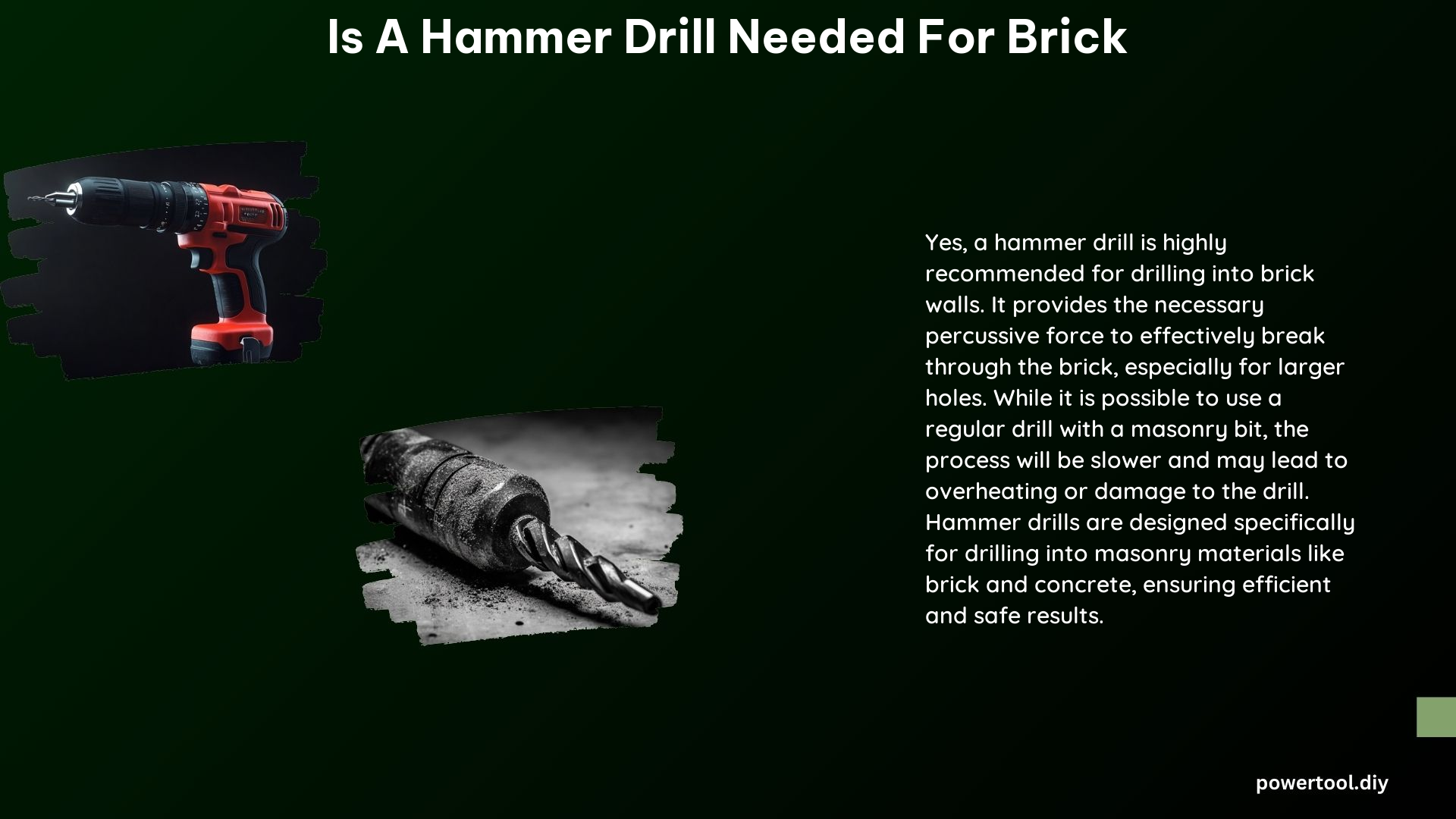A hammer drill is a highly recommended tool for drilling into brick walls due to its superior performance and efficiency compared to a regular drill. This comprehensive guide will delve into the technical details and provide a step-by-step playbook for using a hammer drill to tackle brick projects with ease.
Hammer Drill vs. Regular Drill: The Masonry Advantage
When it comes to drilling into brick, the key difference between a regular drill and a hammer drill lies in their underlying mechanisms. A regular drill relies solely on rotational force to bore through the material, which can be ineffective and slow when dealing with the hardness and density of brick.
On the other hand, a hammer drill incorporates a unique hammering action that delivers rapid, percussive blows in addition to the rotational motion. This dual-action approach allows the drill bit to efficiently break up and penetrate the aggregate structure of brick, resulting in faster and more effortless drilling.
Drill Bit Performance Comparison
| Drill Type | Drilling Speed | Bit Wear | Overheating Risk |
|---|---|---|---|
| Regular Drill | Slower | Higher | Increased |
| Hammer Drill | Faster | Lower | Reduced |
The hammer drill’s hammering mechanism not only enhances the drilling speed but also reduces the wear and tear on the drill bit. This translates to a longer lifespan for your masonry bits and fewer interruptions during the drilling process.
Masonry Drill Bit Selection

When drilling into brick, it’s essential to use the right type of drill bit. Masonry bits, also known as concrete or hammer drill bits, are specifically designed to handle the hardness and abrasiveness of masonry materials.
These bits feature the following key characteristics:
- Carbide Tips: The cutting edges are reinforced with tungsten carbide, providing superior durability and resistance to wear.
- Fluted Design: The spiral flutes help to efficiently clear debris and prevent the bit from overheating.
- Reduced Tip Angle: The sharper point of the bit allows for more precise and controlled drilling into brick.
It’s important to select a bit size that matches the diameter of the hole you need to create. Commonly used masonry bit sizes for brick range from 1/4 inch to 1/2 inch, with 3/8 inch being a popular choice for many household applications.
Safety Considerations
Drilling into brick can be a dusty and noisy process, so it’s crucial to take the necessary safety precautions:
- Eye Protection: Always wear safety glasses or goggles to shield your eyes from flying debris and dust particles.
- Respiratory Protection: Use a dust mask or respirator to prevent the inhalation of harmful silica dust generated during the drilling process.
- Ear Protection: Hammer drills can produce high noise levels, so it’s recommended to wear earplugs or noise-cancelling headphones to protect your hearing.
- Secure the Workpiece: Ensure that the brick wall or surface is firmly secured and stabilized before drilling to prevent any unexpected movements or accidents.
Drilling Techniques for Brick
Proper drilling techniques are essential for achieving clean, accurate holes in brick walls. Follow these steps for optimal results:
- Mark the Drilling Spot: Use a pencil or marker to clearly indicate the desired location of the hole on the brick surface.
- Start with a Pilot Hole: Begin by drilling a small pilot hole, approximately 1/8 inch in diameter, to help guide the larger bit and prevent it from wandering off the marked spot.
- Apply Steady Pressure: Maintain a firm, steady grip on the hammer drill and apply consistent, controlled pressure. Avoid excessive force, as this can cause the bit to bind or the drill to stall.
- Let the Tool Do the Work: Allow the hammer drill’s hammering action and the sharpness of the masonry bit to do the work. Forcing the drill too hard can lead to premature bit wear and potential damage to the tool.
- Clean the Bit Regularly: Periodically pause the drilling and use a wire brush or compressed air to remove any accumulated dust or debris from the drill bit flutes. This will help maintain optimal drilling performance and prevent overheating.
Hammer Drill Options for Brick
When it comes to selecting a hammer drill for brick projects, you have several options to consider:
- Corded Hammer Drills: These are typically more powerful and offer consistent performance, making them suitable for larger-scale or frequent brick drilling tasks.
- Typical Power Range: 6-8 Amps
- Drilling Capacity: Up to 1/2 inch in brick
- Cordless Hammer Drills: Battery-powered hammer drills provide the convenience of mobility and flexibility, making them ideal for smaller, occasional brick drilling jobs.
- Typical Power Range: 12-18 Volts
- Drilling Capacity: Up to 3/8 inch in brick
- Rotary Hammers: These heavy-duty tools are designed for professional-grade masonry drilling and are often used for larger holes or more demanding applications.
- Typical Power Range: 8-12 Amps
- Drilling Capacity: Up to 1 inch in brick
When selecting a hammer drill, consider factors such as the size and frequency of your brick drilling needs, the available power sources, and your budget. For DIY or light-duty brick projects, a cordless hammer drill may be a suitable and cost-effective option, while larger or more frequent tasks may warrant the investment in a corded or rotary hammer model.
Remember, always refer to the manufacturer’s recommendations and safety guidelines when operating any power tool, including hammer drills, to ensure safe and effective use.
Conclusion
In conclusion, a hammer drill is an essential tool for drilling into brick walls. Its unique hammering action, combined with the use of specialized masonry drill bits, makes it a far more efficient and effective choice compared to a regular drill. By following the technical guidance and safety precautions outlined in this comprehensive guide, you can tackle your brick drilling projects with confidence and achieve professional-grade results.
